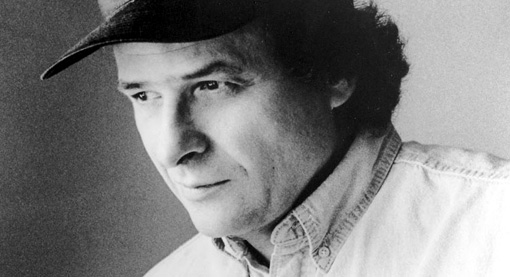
Poetry Dispatch No. 191 | July 20, 2009
Tim O’Brien
(The Art & The Artists of Self Destruction, #7)
In the continuing exploration of art/artists/self destruction, here is yet another area of that subject worthy of comment. How the writer, in particular, creates the narrative, finds the words, creates the mood to capture the reality of that moment with a clarity almost beyond real…anchored in the everydayness of the act, the matter-of-factness of thought and thoughtlessness .
I turn to a passage from Tim O’Brien’s extraordinary novel, IN THE LAKE OF THE WOODS (1994).
I would add about O’Brien, that no American ‘war novelist’ (WW !, WW II, The Korean War…) to my knowledge has ever published four incomparable master works: IF I DIE IN A COMBAT ZONE, GOING AFTER CACCIATO, THE THINGS THEY CARRIED, and IN THE LAKE OF THE WOODS.
Vietnam haunts his most important work…it’s either the back story or the whole story. Given the fact that IN THE LAKE OF THE WOODS is set in his home state, Minnesota… the lake, the woods, the beauty of true north…this brilliant novel would never have achieved the level of narrative artistry O’Brien commands, without the ghost of Vietnam.––Norbert Blei
…This ,was how it was. You go about your business. You carry the burdens, entomb yourself in silence, conceal demon-history from all others and most times from yourself. Nothing theatrical. Shovel snow; diddle at politics or run a jewelry store; seek periodic forgetfulness; betray the present with every breath drawn from the bubble of a rotted past. And then one day you discover a length of clothesline. You amaze yourself. You pull over a garbage can and hop aboard and hook yourself up to forever. No notes, no diagrams. You don’t explain a thing. Which was the art of it—his father’s art, Kathy’s art—that magnificent giving over to pure and absolute Mystery. It was the difference, he thought, between evil and a bad childhood. To know is to be disappointed. To understand is to be be¬trayed. All the petty hows and whys, the unseemly motives, the abscesses of character, the sordid little uglinesses of self and history—these were the gimmicks you kept under wraps to the end. Better to leave your audience wailing in the dark, shaking their fists, some crying How?, others Why?
from IN THE LAKE OF THE WOODS by Tim O’Brien
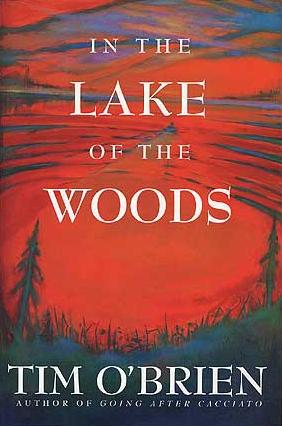 In the Lake of the Woods (1994) is a novel by Tim O’Brien, author of Pulitzer Prize-nominated The Things They Carried. An example of O’Brien’s recurring Vietnam War theme, In the Lake of the Woods follows the struggle of John Wade to deal with a recently failed campaign for the United States Senate. After moving to Lake of the Woods, Minnesota, John discovers one morning that his wife Kathy is missing. Through the use of flashbacks of John’s childhood, college years, and Vietnam experiences, as well as testimony and evidence from affected characters, the novel creatively introduces several hypotheses for the disappearance of Kathy Wade. It won the James Fenimore Cooper Prize for Best Historical Fiction in 1995.
In the Lake of the Woods (1994) is a novel by Tim O’Brien, author of Pulitzer Prize-nominated The Things They Carried. An example of O’Brien’s recurring Vietnam War theme, In the Lake of the Woods follows the struggle of John Wade to deal with a recently failed campaign for the United States Senate. After moving to Lake of the Woods, Minnesota, John discovers one morning that his wife Kathy is missing. Through the use of flashbacks of John’s childhood, college years, and Vietnam experiences, as well as testimony and evidence from affected characters, the novel creatively introduces several hypotheses for the disappearance of Kathy Wade. It won the James Fenimore Cooper Prize for Best Historical Fiction in 1995.
The main storyline often branches out to flashbacks of significant events in John’s past. John’s childhood is constantly referred to as the advent of his persona, Sorcerer. As a child, John was frequently abused verbally and emotionally by his alcoholic father, whom to other children seemed the perfect father. John often visited Karra’s Studio of Magic, but the only item he bought was the Guillotine of Death, purchased by his father. John was devastated after his father’s death. John and Kathy met and became intimate during their college years, despite the number of secrets harbored between the two. John spied on Kathy, which she was aware of, just as he was aware of her affair with the dentist. When John was deployed to Vietnam, he and Kathy conversed through letters, some of which frightened Kathy. John became deeply absorbed in his identity as Sorcerer. Charlie Company was involved in the real-life My Lai massacre but later, while working a desk job in records, John erased his involvement with the Company. Afterwards, John became lieutenant governor of Minnesota and later ran for the US Senate, with his campaign managed by the business-oriented Tony Carbo. John was set to win the election, until the public found out about his involvement in the My Lai Massacre. When the information surfaces, John goes from being way ahead in the polls to eventually losing by a “landslide”.
After his loss, John and Kathy moved to a cottage in Lake of the Woods. They are continuously troubled by the revelation of John’s Vietnam secrets, but pretend to be happy nevertheless. One night John wakes up to boil a kettle of water for tea. Instead of preparing a drink, he pours the boiling water over a few household plants, reciting “Kill Jesus,” which seems to please him. He remembers climbing back into bed with Kathy, but the next morning she’s gone. After a day of walking around the area and discovering the boat’s absence, John talks to his closest neighbors, the Rasmussens. After some time they call the sheriff and organize a search party. The authorities are suspicious of John’s calm demeanor and noninvolvement in the search effort. Kathy’s sister joins the effort and John begins to search for Kathy as well. After eighteen days the search party is called off and the investigation into John heats up. With a boat from Claude and supplies from the Mini-Mart, John heads north on the lake to escape from his problems. Claude is the last person to talk to the disoriented John, over the boat’s radio.
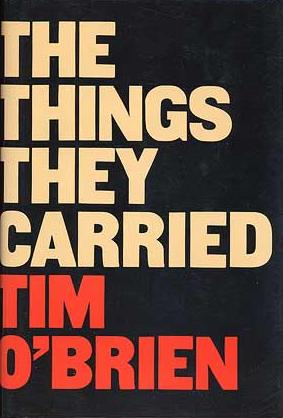 O’Brien introduces a number of theories over the course of the story. Maybe Kathy had sped over the lake too quickly, hit a rough patch of water, and had been violently tossed into the lake, where she drowned. Perhaps she had misnavigated the boat and had become hopelessly lost in the wilderness, only to run out of supplies. Or possibly John had returned to the bedroom with the boiling water and had poured it over her face, scalding her. Afterwards he would have sunk the boat and body in the lake, weighed down by a number of rocks. Or the event might have been John’s last great magic trick, a disappearing act. John and Kathy would have planned her disappearance, and to have John join her later on, after the search efforts had been called off, leaving them to a new start at life. O’Brien introduces numerous pieces of evidence to support these theories, and leaves the decision up to the reader. Although the inconclusive ending irritates many readers, O’Brien tries to argue that this is the truest way to tell a story, which is reminiscent of his other book, The Things They Carried.
O’Brien introduces a number of theories over the course of the story. Maybe Kathy had sped over the lake too quickly, hit a rough patch of water, and had been violently tossed into the lake, where she drowned. Perhaps she had misnavigated the boat and had become hopelessly lost in the wilderness, only to run out of supplies. Or possibly John had returned to the bedroom with the boiling water and had poured it over her face, scalding her. Afterwards he would have sunk the boat and body in the lake, weighed down by a number of rocks. Or the event might have been John’s last great magic trick, a disappearing act. John and Kathy would have planned her disappearance, and to have John join her later on, after the search efforts had been called off, leaving them to a new start at life. O’Brien introduces numerous pieces of evidence to support these theories, and leaves the decision up to the reader. Although the inconclusive ending irritates many readers, O’Brien tries to argue that this is the truest way to tell a story, which is reminiscent of his other book, The Things They Carried.
The present conflict in the story occurs in late 1986, in Lake of the Woods, Minnesota. John and Kathy intentionally choose this setting for its isolation from the outside world, which is desirable to them in their quest to forget the stress and emotion of the failed election. In addition to the immediate setting of the main course of action, the American political environment also pushes into and tensions rise setting up some very interesting theories for Kathy’s disappearance.
Characters in “In the Lake of the Woods”
Main characters
- John Wade – A 41-year-old man at the height of his political career, serves as the central focus of the novel. The lieutenant governor of Minnesota, John was running for the U.S. Senate when he was defeated in a landslide after details of his war actions in Vietnam (My Lai) were uncovered. John and his wife Kathy rent a cottage in Lake of the Woods, Minnesota after the primary to escape the pressures of the outside world. John is repressive of his memory of Vietnam, as well as details of his childhood, including his father’s death. It is worth noting that John’s alter ego or inner anger is the “Sorcerer.”
- Kathy Wade – John’s wife, has been intimately involved with John since their college days. She has stood by John’s side throughout their marriage, despite her fierce inner loathing for the field of politics that serves as John’s passion. Kathy is aware that John represses memories of his past, memories that bubble up in John’s dreams and subconsciousness. In spite of John’s anger and frustration from his loss in a landslide election, Kathy is secretly glad that he will be out of politics and more involved in her life again as she yearned for John’s attention.
Secondary characters
- * Ruth Rasmussen, who, along with her husband Claude Rasmussen, are the closest neighbors to the Wades’ cottage. When Kathy goes missing Ruth supports John and helps him through the search effort.
- * Claude Rasmussen, the husband of Ruth, is the closest thing to a friend John has in the text. John finds several things in common with him and builds a stronger relationship with him through the investigation. Claude helps John prepare his boat and is the last person to contact him before he goes missing.
- * Eleanor Wade is the mother of John. She comments on the isolation John experienced as a child, as well as the transformation of his personality from the effect John’s father had on him.
- * Paul Wade, John’s father, committed suicide when John was a child. An alcoholic and often abusive father, Paul was nevertheless idolized by John, and consequentially his death devastated John. John always struggled with the notion that Paul didn’t offer him affection which affected him throughout his life.
- * Patricia S. Hood, The sister of Kathy, who never trusted John. Kathy often confided in her when she could no longer hold in the pressures of her relationship. Patricia assists on the search efforts when she hears the news of her missing sister, and becomes annoyed and suspicious at John’s reluctance to get involved with the search.
- * Arthur Lux is the sheriff of Lake of the Woods County. He heads the investigation in charge of the search for Kathy Wade.
- * Vinny Pearson runs the Texaco station in town while also serving as the police for the general area. Upfront and accusative, Vinny suspects John’s guilt from the onset of the search effort and investigation.
- * Myra Shaw, Vinny’s cousin, is an obese girl who works at the Mini-Mart. She observes John and Kathy fighting while eating dinner and later on witnesses John buying supplies before he disappears.
- * Anthony (Tony) Carbo served as John’s campaign manager through his political career. He is described as overweight and physically repulsive, and appears only concerned with winning. Though he is not personally attached to John, Tony still felt betrayed that John hid the secrets from Vietnam from him. Tony’s physical attraction to Kathy Wade becomes evident, and at one point he makes a reference to masturbating over her. He could be the physical embodiment of the ugly side of politics.
- * Sandra Karra, known to John as the Carrot Lady, owns Karra’s Studio of Magic. She speculated that John had a crush on her as a child, because of his frequent visits to the shop and his fascination with her.
- * The many men of Charlie Company were mentally deteriorated by the magical land of Vietnam, as well as the lack of a visible enemy. The events at My Lai were a means for them to strike back at what they thought was the enemy.
- * PFC Weatherby is a soldier in John’s Charlie Company. In the heat of battle John shoots Weatherby in the head and later blames his death on the Viet Cong. It is debatable whether he does this on purpose or not.
- * Richard Thinbill begged for John to release the events at My Lai to the authorities, but was persuaded by John not to. He is haunted by the sound of flies in the years after the war and is eventually the person that reveals that John was a member of Charlie Company. source
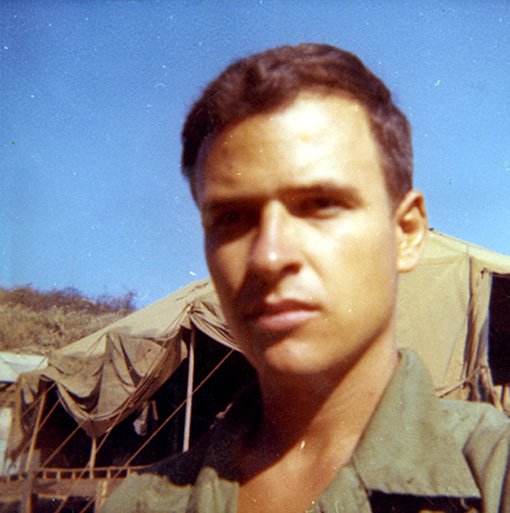
Tim O’Brien in Vietnam circa 1969
Tim O’Brien (born October 1, 1946 in Austin, Minnesota) is an American novelist who mainly writes about his experiences in the Vietnam War and the impact the war had on the American soldiers who fought there. He currently holds the Mitte Chair in Creative Writing at the MFA program of Texas State University-San Marcos.
He was born in Austin, Minnesota, a town of about 20,000 people (a setting which figures prominently in his novels). When O’Brien was twelve, his family, including a younger sister and brother, moved to Worthington, Minnesota, a place that once billed itself as “the turkey capital of the world.” Worthington had a large influence on O’Brien’s imagination and early development as an author. The town is located on Lake Okabena in the western portion of the state and serves as the setting for some of his stories, especially those in the collection titled The Things They Carried. He earned his BA in Political Science from Macalester College in 1968. That same year he was drafted into the Army and was sent to Vietnam, where he served from 1968 to 1970 in 3rd Platoon, A Co., 5th Batt. 46th Inf., as an infantry foot soldier. O’Brien’s tour of duty was 1969-70. He served in the Americal Division, a platoon of which participated in the infamous My Lai Massacre. O’Brien has said that when his unit got to the area around My Lai (referred to as “Pinkville” by the U.S. forces), “we all wondered why the place was so hostile. We did not know there had been a massacre there a year earlier. The news about that only came out later, while we were there, and then we knew.”
Upon completing his tour of duty, O’Brien went on to graduate school at Harvard University and received an internship at the Washington Post. His writing career was launched in 1973 with the release of If I Die in a Combat Zone, Box Me Up and Ship Me Home, about his war experiences. In this memoir, O’Brien writes: “Can the foot soldier teach anything important about war, merely for having been there? I think not. He can tell war stories.”
While O’ Brien insists it is not his job or his place to discuss the politics of the Vietnam War, he does occasionally let fly. Speaking years later about his upbringing and the war, O’Brien called his hometown “a town that congratulates itself, day after day, on its own ignorance of the world: a town that got us into Vietnam. Uh, the people in that town sent me to that war, you know, couldn’t spell the word ‘Hanoi’ if you spotted them three vowels.” Contrasting the continuing American search for U.S. MIA/POWs in Vietnam with the reality of the Vietnamese war dead, he calls the American perspective “A perverse and outrageous double standard. What if things were reversed? What if the Vietnamese were to ask us, or to require us, to locate and identify each of their own MIAs? Numbers alone make it impossible: 100,000 is a conservative estimate. Maybe double that. Maybe triple. From my own sliver of experience — one year at war, one set of eyes — I can testify to the lasting anonymity of a great many Vietnamese dead.”
One attribute in O’Brien’s work is the blur between fiction and reality; labeled “metafiction,” his work contains actual details of the situations he experienced; while that is not unusual, his conscious, explicit, and metafictional approach to the distinction between fiction and fact is extraordinary: In the chapter “Good Form” in The Things They Carried, O’Brien casts a distinction between “story-truth” (the truth of fiction) and “happening-truth” (the truth of fact or occurrence), writing that “story-truth is sometimes truer than happening-truth.” Story truth is emotional truth; thus the feeling created by a fictional story is sometimes truer than what results from reading the facts. Certain sets of stories in The Things They Carried seem to contradict each other, and certain stories are designed to “undo” the suspension of disbelief created in previous stories; for example, “Speaking of Courage” is followed by “Notes,” which explains in what ways “Speaking of Courage” is fictive.
O’Brien received the National Book Award in 1979 for his book Going After Cacciato. His novel In the Lake of the Woods won the James Fenimore Cooper Prize for Best Historical Fiction in 1995. His most recent novel is July, July. O’Brien’s papers are housed at the Harry Ransom Center at the University of Texas at Austin.
“Though it’s odd, you’re never more alive than when you’re almost dead.” – Tim O’Brien
Works
- * If I Die in a Combat Zone, Box Me Up and Ship Me Home (1973)
- * Northern Lights (1975)
- * Going After Cacciato (1978)
- * The Nuclear Age (1985)
- * The Things They Carried (1990)
- * In the Lake of the Woods (1994)
- * Tomcat in Love (1998)
- * July, July (2002)
- * Where Have You Gone Charming Billy?
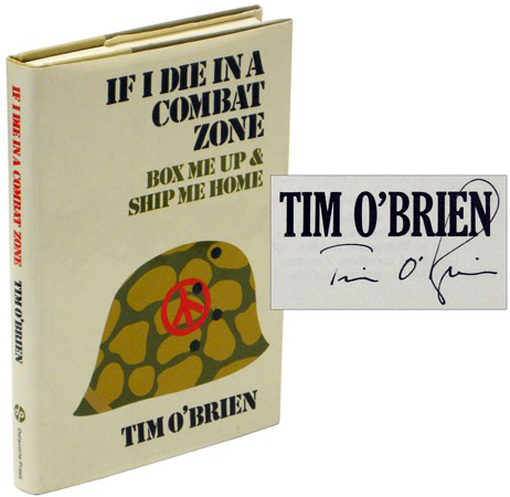


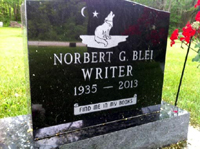



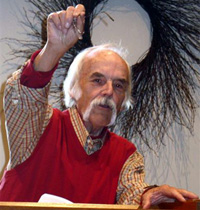




















































Leave a comment